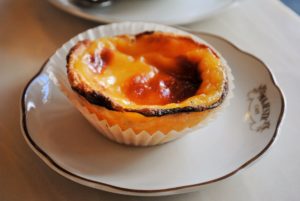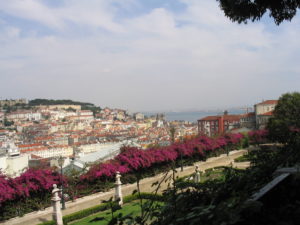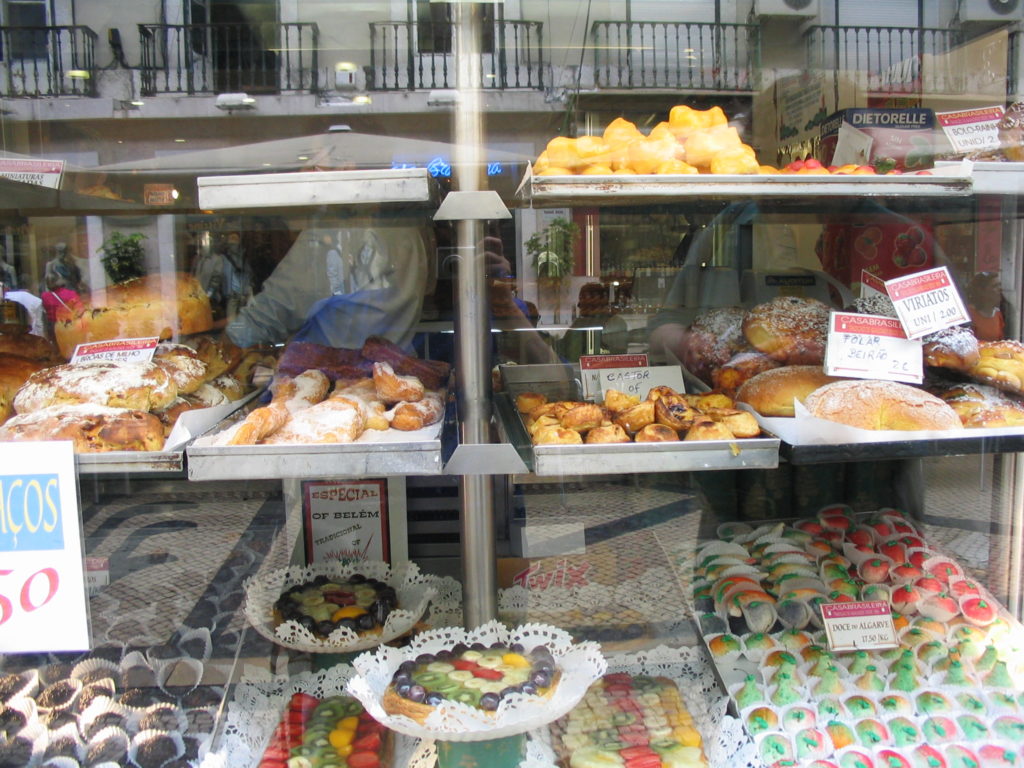How Sweet It Is: Portugal’s Egg Custard Tart

Pastel de Nata
Some years back, my wife, Peggy, and I were on a pilgrimage to Belém (Bethlehem), a district in Lisbon a short distance from the city center—not to visit religious sites, although there were hallowed monuments at our destination. We were heading there to sample the pastel de nata, the country’s celebrated egg custard tart, at its most renowned purveyor, the bakery Antiga Confeitaria de Belém. These were not just ordinary pastéis, which are commonplace throughout the city, but pastéis de Belém, pastries reputed to have come from the original recipe.
Belém is the site of the Torre (tower) de Belém, a fortress erected in an imperial age to guard the mouth of the Tagus River. The poet Fernanda Pessoa called the tower “a magnificent stone jewel.” This outpost was Portugal’s gateway for voyages bound for the East. It was where Vasco da Gama launched his journey to India in 1496 and where other captains embarked in their pursuit of gold and spices. Close to the tower is the impressive monastery, Mosteiros Jerónimos, home to clerics and a resting place where Vasco da Gama and other notables are entombed.
In days past, tourists eager to visit these shrines would climb aboard steamboats at Lisbon’s docks to make the trip to Belém. Now, tour buses arrive to bring visitors like us to the Confeiteria. Customers place their orders for tarts, which come to the counter hot from the oven. The pastries are sweet and creamy, with blackened caramelized patches atop the custard. They also have delightfully flaky crusts. Customers can sprinkle cinnamon and powdered sugar on the pastries.
The café has a series of interconnecting rooms decorated with typical Portuguese blue and white tiles where patrons savor their pastéis, often with a galão, coffee with a bit of milk, or a bica, an espresso. The reverent visitors frequently leave with tarts in specially designed paper packages. They are “wrapped in pairs, married one on top of the other,” one admirer observes.

A view of Lisbon and the Tagus River
An aura of mystery still surrounds these tarts. They are said to be baked “by master confectioners” who tightly guard the secret recipe. The pastel de nata tradition originated with the Monastery, where convent nuns devised a recipe for these temptations and began selling them. Convents and monasteries in the sixteenth and seventeenth centuries were much more than religious institutions. They were also festive places for royal banquets, birthdays, and weddings.
Eggs, whose yolks were central to the making of these custards, were abundant in convent kitchens. Ovos provided a basic protein in the dietary regimen of the religious orders. Chickens, a common sight around the peasant household in Portugal, were a source of currency. They were bartered for meat and other dearer items or simply sold to make money. Convents frequently bought their eggs from the poor.
Eggs remain a mainstay of both sweet and savory Portuguese cooking, writer Andrea Smith points out. They are mixed into many bacalhau (cod) dishes like Bacalhau a Brás, which features salt cod fried with potatoes, onions, and scrambled eggs. Or they may flavor a bread soup, which comes with a poached egg. Even a fried egg, historian Virgilia Nogueiro Gomes notes, could be ennobled: “Frying an egg was an art. It was used with savory food and could be served as a dessert, topped with sugar to make the yolk very creamy. Then we could make little bread soups in the sugar-filled yolk. . . . The difficult part was ensuring that the egg white was well cooked and the yolk was still runny.”
The word for fried egg, estrelar, Andrea Smith suggests, may have a celestial association because it is derived from estrela, the word for star. I have speculated, myself, that the term Pastel de Nata may also have Christian overtones. The word nata has its roots in Portuguese words relating to “birth.”
The nuns used beaten egg whites in ironing clothing. Priests’ robes, nuns’ habits and headdresses received this treatment. The many leftover yolks, the story goes, were exploited to make doces conventuais (convent sweets)—puddings, custards, and other sweets. At fairs and other celebrations, nuns vied with each other to prepare the best confections.
The convents were crucibles of pastry creation. The names of sweets reflect their strong religious inheritance. Pão de Deus (god’s bread) is a bun with a luxuriant sweet coconut topping. There were other confections called “nuns’ tummies,” “angels’ cheeks,” and “bacon from heaven.”
Custard tarts were sold at the monastery until the early nineteenth century. The Liberal Revolution of 1820 in Portugal, however, forced the closing of religious institutions. The original pastel de nata recipe, it is said, was bought by a nearby bakery. “Until the nineteenth century, monasteries were Portugal’s research, trade, horticultural, and confectionary epicenters, around which rose small businesses,” food writer David Leite remarks in his blog, Leite’s Culinaria. In the same location, today’s Confeiteria carries on the tart-making tradition.

Pasteis de nata amid a variety of Portuguese sweets
The pastel de nata was transported throughout Portugal’s far-flung empire. It arrived in China, India, and Brazil, where the Iberians brought their convent sweets, along with their passion for sugar. The Portuguese, food historian Janet P. Boileau notes, were well known for their tastes: “‘There was no nation in the world so fond of sweetmeats as the Portuguese; they always handed them about on their social visits,’ the Dutchman Jacobus Canter Visscher wrote while visiting Goa in the 1750s.”
The colonists, Boileau points out, offered sweets as gifts to foreign dignitaries. She describes the luxurious array of sweets Vasco da Gama presented to the local king in Malindi, on the coast of Kenya: “When the king was entertained on board da Gama’s vessel, the dignitary was conducted to the quarterdeck, where a handsome table had been set out, with gold-embroidered Flemish napkins. He was offered a variety of conserves, confectionery, preserved almonds, olives and marmalade, served in silver dishes and accompanied by wine in gilt vessels.”
In former Portuguese colonies, bakers have invented their own version of the egg custard tart. In Macao, an English businessman opened a shop, which he called “Andrew Stow’s Coffee and Natas.” Lord Stow then franchised his bakery in Hong Kong. The trend has picked up steam. “Egg tart fever hit Hong Kong, Singapore and Taiwan in the late 1990s,” Andrea Nguyen writes.

Traditional Portuguese blue and white tiles
In Portuguese immigrant enclaves abroad, expatriates have also introduced their confections. I remember discovering sweet bread, pão doce, in the old fishing port of New Bedford, Massachusetts. Available in the region’s supermarkets, the bread, once reserved for holidays in Portugal, has become a routine treat. (A diner in Fairhaven, across the river from New Bedford, enticed its customers with chouriço—Iberian sausage—omelettes.) On my many excursions to Newark, New Jersey, the second largest Portuguese settlement on the East Coast, I found pastéis de natas and a plethora of other sweets in bakeries, cafes, and restaurants. Sugar seemed to be an important part of Portuguese culture. On an early visit to the Ironbound, Newark’s Portuguese neighborhood, I was captivated as Carlos Fernandes, the owner of Play Ball, a local eatery, plunged a 3-foot stalk of sugar cane into a juicer. He then served me a refreshing sugar cane drink known as garapa.
At the time, I hadn’t realized how bound up Portugal was with the history of sugar. Conquering Muslims, who had learned the basics of sugar making in Persia and India, first took the crop west to the Middle East and into the Mediterranean. As the late anthropologist Sidney Mintz, the author of the history Sweetness and Power, comments: “sugar … we are told, followed the Koran.” The Moors, who gained control of the Iberian Peninsula in 711 A.D., ruled Portugal for five centuries. The occupiers, who planted sugar cane in the Algarve in southern Portugal, communicated their affection for sweets like candied fruits and almond-flavored egg yolk pastries. Before the Portuguese colonized Brazil in the early sixteenth century and started producing sugar for export to Lisbon, the Iberians had schooled themselves in sugar cultivation in their Atlantic colonies off the west coast of Africa—Madeira, the Azores, and São Tomé. The settlers, who were growing cane in Madeira by 1452, transformed the island briefly into the world’s largest exporter of sugar. “These islands,” Mintz observes, “were the stepping stones by which the [sugar] industry would move from the Old World to the New.” On his second voyage, Columbus, who had learned about sugar planting while working in Madeira, introduced cane to the Americas. In 1493, he carried it to the island of Hispaniola (which consists of the present-day countries of Haiti and the Dominican Republic) in 1493 from the Canary Islands (the Spaniards, who had colonized these islands, had also been keen sugar planters).
The pastel de nata enthusiasm continues to spread, even beyond the Portuguese diaspora. In recent years, shops in England have sprung up selling “Portuguese Egg Custard Tarts.” Berlin’s Café Galão, owned by a German businessman who became acquainted with the Portuguese in Hamburg, is a popular purveyor of custard tarts.
Some promoters of Portuguese foods would like to see them more widely disseminated. The minister of the economy, Álvaro Santos Pereira, highlighted the pastel de nata as an example of the nation’s “export potential,” the Portuguese Daily View reported. He urged confectioners to expand the global sales of the custard tart. Why was there not a “franchise of pastéis de nata,” he asked participants at a conference on competitiveness.
Other devotees of the pastry look more askance at its adoption abroad. Frederico Duarte, a designer who has researched his country’s baking industry, believes the custard tart is not easily replicated. The unique qualities of the Portuguese oven explain the pastel de nata’s supremacy: “From what they have explained to us, you have to have a furnace that bakes at 400 degrees and you rarely find one that does it abroad,” he told Lusa News Agency [the temperature is probably centigrade]. “That’s why cream pies abroad are almost always bad.” Outside of Portugal, the tart, Duarte says, is a pale imitation of the original. In Macao, he argues, the pastel is “adulterated.”
For myself, I can be satisfied with a pastel de nata that is short of perfection. As I prepare for a trip to Montreal, which has a large Portuguese community, and a visit to my favorite bakery, Patisserie Notre Maison, I yearn for their egg custard tarts. They may not be pastéis de Belém, but they’re still divine.







